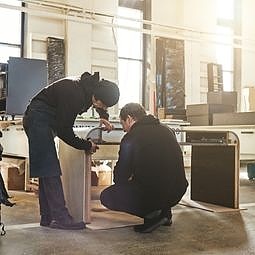
For any industry, you want a warehouse workstation that is ergonomic and efficient, and one that's designed to complete that role as quickly as possible without sacrificing quality. These workstations also have to account for multiple craftsmen using them, which makes it tricky to determine the most efficient design when each person has their own needs for completing their work. To help, here are three steps for creating a standard lean workstation.
When designing a lean workstation, you want to make sure everyone is involved in the process. You can't make an efficient workstation if you don't know what the needs of your workers are and what issues they may face that will need to be solved. Rather than guessing or assuming, getting first-hand accounts of needs and involving tradesmen in the design process will ensure the workstation is designed to fulfill the right needs. This process will also help find compromises between conflicting ideas and needs that may interfere with another role's work, so it's important that such differences are mediated during this phase of creation.
The next step in creating a standard lean workstation is to ensure and enforce safety measures. If workstations cannot adapt or minimize hazards, then you should be using them at all. While you're trialing and mocking up workstation designs, keep your health and safety people involved to help identify potential hazards that could harm your workers. Furthermore, if a workstation is merely a mockup, then it should be clearly labeled “Not for Production†to prevent unsafe workstations from being used unknowingly.
Failure will almost always be a part of the process. Don't hesitate to trial and error potential workstation designs to see if they perform as well as they seem to on paper. A lot of ideas may sound good in theory, but some aren't able to perform as well as you may have hoped in practice—or could even be dangerous. Trial and error will also help you improve workstations to be more efficient and effective as you find out what works and what doesn't.